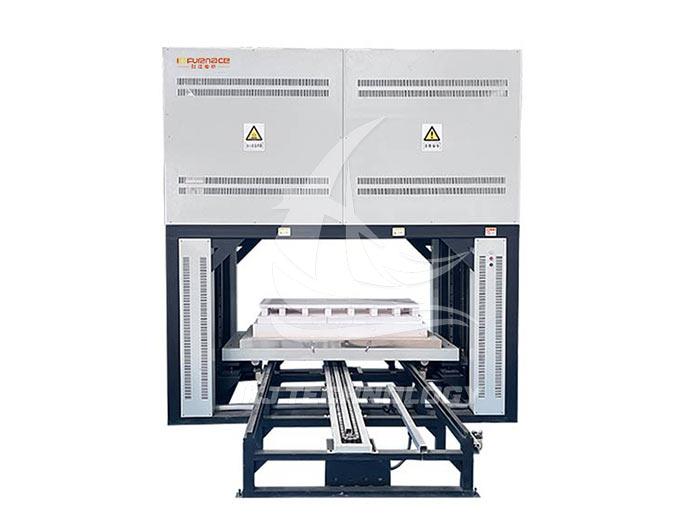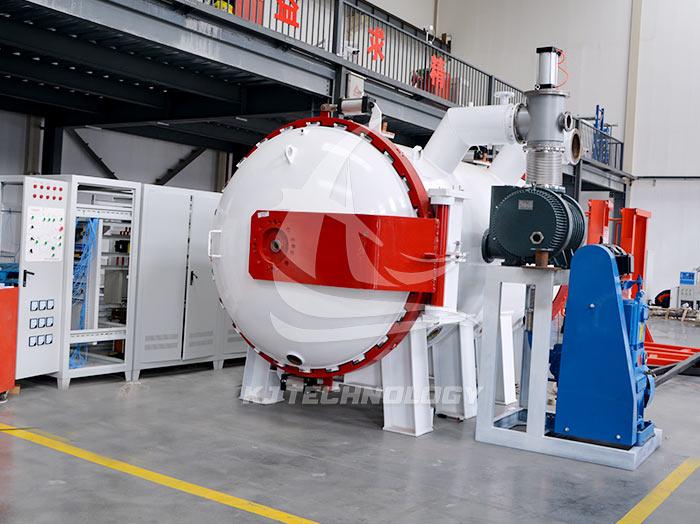Precautions for using customized ceramic sintering vacuum furnace
 08-28-2025 Author: KJ technology
08-28-2025 Author: KJ technology
When using a customized ceramic sintering vacuum furnace, strict control is required from four aspects: preparation before operation, monitoring during operation, safety protection, and maintenance to ensure stable operation of the equipment, meet sintering quality standards, and extend service life. The following are specific precautions:
1. Preparation before operation: Ensure that the equipment and materials are compatible
Equipment inspection
Vacuum system: Check the oil level and quality of the vacuum pump (whether it is emulsified or discolored), ensure that the sealing ring is free of aging cracks, and test whether the vacuum degree can meet the process requirements (such as 1 × 10 ⁻⁴ Pa).
Heating system: Confirm that the heating elements (graphite, tungsten, etc.) are not broken or oxidized, and that the wiring terminals are securely fastened without looseness.
Cooling system: Check whether the water cooling pipeline is unobstructed, the water flow pressure is stable, and avoid equipment damage caused by insufficient cooling.
Temperature sensor: Use a standard thermometer to verify the accuracy of the thermocouple or infrared thermometer, ensuring that the temperature control error is within ± 1 ℃ (high-precision demand scenario).
Material Preparation
Pre treatment: Ceramic green bodies need to be thoroughly dried to prevent cracking during sintering; Metallized ceramics need to be cleaned of surface oil stains to avoid affecting welding quality.
Furnace loading method:
Avoid direct contact of materials with heating elements and use alumina or silicon carbide firing plates for isolation;
Uniform distribution of material racks to prevent local overheating (temperature uniformity should be controlled within ± 5 ℃);
Transparent ceramics require high-purity alumina gaskets to reduce impurity pollution.
Process parameter setting
Heating rate: Set in sections according to material characteristics (such as alumina ceramics: heating rate ≤ 5 ℃/min from room temperature to 600 ℃, and sintering temperature ≤ 3 ℃/min from 600 ℃ to sintering temperature).
Insulation time: Ensure that the material is fully densified (e.g. silicon nitride ceramics need to be insulated at 1750 ℃ for 4 hours).
Atmosphere control: Non oxide ceramics (such as SiC) need to be filled with high-purity argon gas (purity ≥ 99.999%) to prevent oxidation; Transparent ceramics require ultra-high vacuum (≤ 1 × 10 ⁻⁴ Pa) to eliminate pores.
2. Running monitoring: real-time response to abnormal situations
Temperature monitoring
Observe whether the temperature curve is consistent with the set program. If there is "overshoot" or "hysteresis", check the PID parameters or heating element power.
Sudden temperature increase or decrease may indicate thermocouple malfunction or power fluctuation, and immediate shutdown is required for troubleshooting.
Vacuum monitoring
Record the vacuum pumping time (e.g. ≤ 10 minutes from atmospheric pressure to 10 Pa). If the time is prolonged, it may be due to aging of the vacuum pump or leakage of the furnace body.
The decrease in vacuum degree during the sintering process (such as from 1 × 10 ⁻⁴ Pa to 1 × 10 ⁻³ Pa) may be due to material gas release, and it is necessary to evaluate whether it affects the quality.
Pressure monitoring (hot press furnace)
Confirm that the hydraulic system pressure is stable (such as a 500 ton hot press furnace pressure fluctuation of ≤± 5 tons), to avoid material cracking caused by sudden pressure changes.
Observe whether the pressure temperature curve matches to prevent density failure caused by insufficient pressure.
3. Security protection: Avoiding operational risks
high-temperature protection
Wear insulated gloves and protective face shields during operation to avoid direct contact with the furnace door and heating elements (surface temperature can reach 2400 ℃).
Warning signs should be set up around the furnace body to prohibit unrelated personnel from approaching.
Vacuum system safety
When shutting down, first break the vacuum to atmospheric pressure before opening the furnace door to prevent negative pressure from injuring the operator.
Regularly check the safety valve of the vacuum pump (such as setting the pressure to 0.1 MPa) to avoid overpressure explosion.
Electrical safety
Ensure good grounding of the equipment to prevent electric leakage and shock.
Do not plug or unplug temperature sensors or heating element wiring during device operation to avoid arc burning of the control cabinet.
Gas safety
When introducing argon or nitrogen gas, check the pressure of the gas cylinder and the sealing of the pipeline to prevent gas leakage from causing suffocation or explosion.
Equipped with gas leakage alarm device (such as argon gas detector), it will automatically shut down and sound an alarm when the concentration exceeds the standard.
4. Maintenance and upkeep: Extend equipment lifespan
routine maintenance
Cleaning: Clean the residue (such as alumina powder) in the furnace after each use to avoid affecting the quality of the next sintering.
Lubrication: Regularly add high-temperature resistant grease (such as molybdenum disulfide) to the vacuum pump bearings to reduce wear.
Tightening: Check if the furnace body bolts and electrode wiring terminals are loose to prevent poor contact from causing faults.
regular maintenance
Every 3 months: replace the vacuum pump oil and clean the oil filter; Check if the thermocouple protective sleeve is cracked.
Every 6 months: calibrate temperature controller and vacuum gauge; Detect the resistance value of the heating element.
Every year, a professional organization is commissioned to conduct X-ray inspection on the furnace body to check for cracks or deformations in the insulation screen and heating chamber.
Management of vulnerable parts
Reserve commonly used spare parts (such as graphite heating rods, O-ring seals, thermocouples) to avoid production disruptions caused by downtime waiting for spare parts.
Record the spare parts replacement cycle and develop a procurement plan in advance.








